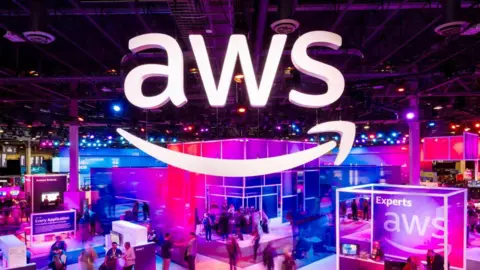By Sean McManus, Technology reporter
 David Heinemeier Hansson
David Heinemeier HanssonThis year, software firm 37signals will see a profit boost of more than $1m (£790,000) from leaving the cloud.
“To be able to get that with such relatively modest changes to our business is astounding,” says co-owner and chief technology officer, David Heinemeier Hansson.
The US company has millions of users for its online project management and productivity software, including Basecamp and Hey.
Like many companies it outsourced data storage and computing to a third party firm, a so-called cloud services provider.
They own huge data centres, where they host data from other firms, which can be accessed over the internet.
In 2022, such services cost 37signals $3.2m.
“Seeing the bill on a weekly basis really radicalised me,” Mr Heinemeier Hansson says.
“I went: ‘Wait! What are we spending for a week of rentals?’ I could buy some really powerful computers just on one week’s worth of [cloud] spending.”
So, he did. Buying hardware and hosting it in a shared data centre costs $840,000 per year.
Although costs pushed Mr Heinemeier Hansson to act, other factors were also a concern.
The internet is engineered to be highly resilient.
“I saw the distributed design erode as more and more companies gravitated essentially to three owners of computers,” he says, referring to the three leading cloud providers.
If a major data centre goes down, large parts of the web can go offline.
The cloud was pitched, he says, as cheaper, easier, and faster. “The cloud was not able to make things easier to a point where we could measure any productivity gains,” he says, noting his operations team has always been about the same size.
Was using the cloud faster?
“Yes, but it didn’t matter,” says Mr Heinemeier Hansson.
“If you want to connect a hundred servers to the internet, you can do it in less than five minutes [in the cloud]. That’s incredible.
“But we do not need, nor do I believe the vast majority of companies need, a five-minute turnaround on a massive number of additional servers.”
He can have new servers delivered and racked in his data centre in a week, which is fast enough.
37signals does use the cloud for experimenting with new products. “We needed to have some big machines, but we only needed them for 20 minutes,” Mr Heinemeier Hansson says.
“The cloud is ideal for that. It would be wasteful to buy that computer and let it stay idle for 99.99% of the time.”
He still recommends the cloud to fledgling businesses. “When you have a speculative start-up and there’s great uncertainty as to whether you’re going to be around in 18 months, you should absolutely not spend your money buying computers,” he says. “You should rent them.”
 Getty Images
Getty Images37signals is not alone in bringing workloads back from the cloud, which is known as cloud repatriation.
Digital workspace company Citrix found that 94% of large US organisations it surveyed had worked on repatriating data or workloads from the cloud in the last three years.
The reasons cited included security concerns, unexpected costs, performance issues, compatibility problems and service downtime.
Plitch provides software that enables people to modify single-player games, including adjusting the difficulty.
It built its own private data centres and repatriated cloud workloads to them, saving an estimated 30% to 40% in costs after two years.
“A key factor in our decision was that we have highly proprietary R&D data and code that must remain strictly secure,” says Markus Schaal, managing director at the German firm.
“If our investments in features, patches, and games were leaked, it would be an advantage to our competitors. While the public cloud offers security features, we ultimately determined we needed outright control over our sensitive intellectual property.
“As our AI-assisted modelling tools advanced, we also required significantly more processing power that the cloud could not meet within budget.”
He adds: “We encountered occasional performance issues during heavy usage periods and limited customisation options through the cloud interface. Transitioning to a privately-owned infrastructure gave us full control over hardware purchasing, software installation, and networking optimized for our workloads.”
 Pulsant
PulsantMark Turner, chief commercial officer at Pulsant, helps companies to migrate from the cloud to Pulsant’s colocation data centres across the UK.
In a colocation arrangement the client owns the IT hardware, but houses it with another firm, where it can be kept securely, at the right temperature and with power back-up.
“The cloud is going to continue to be the biggest part of IT infrastructure, but there is a good place for local, physical, secure infrastructure,” he says. “There is a repatriation going on of the things that should never have been in the cloud or that won’t work in the cloud.”
Some his biggest clients for repatriation are online software providers, where each additional customer puts more load on the server, increasing cloud costs.
One such client is LinkPool, which enables smart contracting using blockchain. It was developed in public cloud, initially using free credits. Business exploded, and the cloud bill reached $1m per month. Using colocation, costs shrunk by up to 85%.
“[The founder has] now got four racks in a data centre in the city where he lives and works, connected to the world. He goes up against his competitors and he can move his price point around because his cost is not going to move in line [with customer demand],” says Mr Turner.
“The change leaders in the IT industry are now the people who are not saying cloud first, but are saying cloud when it fits,” he adds. “Five years ago, the change disruptors were cloud first, cloud first, cloud first.”
Of course, not everyone is repatriating. Cloud computing will remain an enormous business, with AWS, Microsoft’s Azure and Google Cloud Platform being the biggest players.
For firms like Expedia, they are essential.
It has used the cloud to consolidate 70 petabytes of travel data from its 21 brands.
Applications run in the cloud, too, except for legacy software that doesn’t work there yet.
“We are experts in travel,” says Rajesh Naidu, chief architect and senior vice president, Expedia. “[Cloud providers] are experts in running infrastructure. That’s one less thing for me to worry about while we focus on running our business.”
“One of the main things the cloud gives us is a global presence, the ability to deploy our solutions closer to the region that they need to be in,” he says.
“The other thing is the resiliency and the availability of the infrastructure. Cloud providers have designed and architected their infrastructure really well. We can ride on the coattails of their innovation.”
Expedia has a cloud centre of excellence, which saved about 10% on cloud costs last year.
“You’ve got to set policies because otherwise it’s easy for companies to run huge cloud costs,” Mr Naidu says. “You can turn things down when you don’t need them. If you consume [cloud resources] wisely, your bill won’t be a surprise at the end of the day.”















































